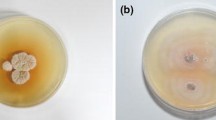Abstract
In this paper we report a case of onychomycosis caused by Chaetomium globosum. The patient had lesions of the fingernails of the left hand. The direct microscopical examination of the nails showed light-brown hyphae with thick-walled cells. The histopathological examination revealed thick aggregated hyphal element in the nail plate. Amongst the antimycotics tested oxiconazole with MIC values of 0.3 μg/ml−1 was found to be most effective in vitro against Chaetomium globosum.
Similar content being viewed by others
References
Ajello L. Hyalohyphomycosis and phaeohyphomycosis. Two global disease entities of public health importance. Eur J Epidemiol 1986; 2: 243–51.
Almeida F De, Gomes JM, Salles C. Consideracoes sobre uma amosta de ‘Chaetomium’ isolda de uma lesao epidermica. An Fac Med Univ Sao Paulo 1944; 20: 145–54.
Campbell CK, Aziz Kurwa, Abdel-Aziz AHM, Hodgson C. Fungal infection of skin and nails by Hendersonula toruloidea. Br J Dermatol 1973; 89: 45–52.
Costa AR, Porto E, Lacaz C Das, De Melo NT, Calux M De JF, Valente NYS. Cutaneous and ungual phaeohyphomycosis caused by species of Chaetomium Kunze (1817) ex Fresenius, 1829. J Med Vet Mycol 1988; 26: 261–8.
English MP. Nails and fungi. Br J Dermatol 1976; 94: 697–701.
Field MH. Opportunistic fungal infections. J Am Med Women's Assoc 1968; 23: 529.
Fragner P, Belson I. Scopulariopsis Bainer as causative agent of onychomycosis. Acta Univ Carol 1974; 20: 333–58.
McGinnis MR. Chaetomium Kunze ex Fries, 1829. In: MR McGinnis, Laboratory Hand Book of Medical Mycology. New York, Academic Press, 1980.
McGinnis MR, Sorrell DF, Miller RL, Kaminski GW. Subcutaneous phaeohyphomycosis caused by Exophiala moniliae, Mycopathologia 1981; 73: 69–72.
Polak A. Antifungal activity ‘in vitro’ of Ro 14-4767, A phenyl propyl morpholine. Sabouraudia 1983; 21: 205–13.
Rippon JW. Medical Mycology. The pathogenic fungi and the pathogenic actinomycetes, 2nd ed. Philadelphia, WB Saunders, 1982.
Schell WA. Medically important dematiaceous fungi. Synopsis of distinctive characters. Pan American Health Organization. 6th Pan American Conference on the Mycoses, Cartagena, Colombia, 1983.
Singh SM, Barde AK. Hendersonula toruloidea infection of skin and nails. Indian J Dermatol Venerol Lepr 1980; 48: 350–5.
Singh SM, Barde AK. A case of onychomycosis caused by Aspergillus sclerotiorum. Indian J Dermatol Venerol lepr 1983; 49: 22–5.
Singh SM, Barde AK. Non-dermatophytic infection of skin and nails. Mykosen 1986; 29(6): 272–7.
Wadhwani K, Shrivastava AK. Some cases of onychomycosis from North India in different working environments. Mycopathologia 1985; 92: 149–55.
Zaias N. Onychomycosis. Arch Dermatol 1972; 105: 263–74.
Author information
Authors and Affiliations
Rights and permissions
About this article
Cite this article
Naidu, J., Singh, S.M. & Pouranik, M. Onychomycosis caused by Chaetomium globosum Kunze. Mycopathologia 113, 31–34 (1991). https://doi.org/10.1007/BF00436384
Received:
Accepted:
Issue Date:
DOI: https://doi.org/10.1007/BF00436384




